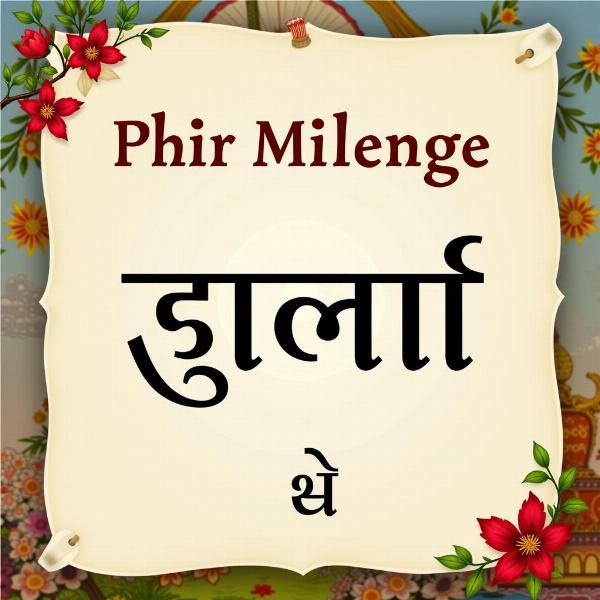Understanding the nuances of “see you” in Hindi can enrich your cross-cultural communication. This guide explores various ways to say “see you” in Hindi, delving into their cultural context and providing practical examples. “See you hindi meaning” encompasses more than just a literal translation; it reflects the warmth and respect embedded in Indian interactions.
Different Ways to Say “See You” in Hindi
Hindi offers a rich vocabulary to express the sentiment of “see you,” each with its own subtle implications. Let’s explore some of the most common expressions:
-
फिर मिलेंगे (Phir milenge): This is the most common and versatile equivalent of “see you.” It literally translates to “we will meet again” and is suitable for both formal and informal settings.
-
जल्दी मिलते हैं (Jaldi milte hain): This phrase implies “see you soon” and is used when you expect to meet the person again shortly.
-
अलविदा (Alvida): This is a more formal way of saying goodbye, similar to “farewell.” It’s typically used when you don’t anticipate seeing the person again soon, or at the end of a significant event.
-
तब तक के लिए (Tab tak ke liye): This translates to “until then” and is used when you’re parting ways but plan to reconnect later, often at a specified time or event.
-
चलते हैं (Chaltein hain): While literally meaning “let’s go,” this phrase is often used as an informal “see you later” among friends.
 Phir Milenge in Hindi Script
Phir Milenge in Hindi Script
Cultural Context of Saying “See You” in Hindi
Indian culture places a strong emphasis on relationships and respect. Saying goodbye is rarely a simple act; it often involves expressing good wishes and acknowledging the connection. This is reflected in the various ways to say “see you” in Hindi. The choice of phrase often depends on the relationship with the person, the formality of the situation, and the anticipated time until the next meeting.
For example, using “phir milenge” with an elder shows respect, while “chaltein hain” is appropriate for close friends. Understanding these nuances can significantly enhance your communication and build stronger relationships.
Common Scenarios and Their Appropriate “See You” Phrases
Here are some common scenarios and the most suitable Hindi phrases to use:
-
Leaving a business meeting: फिर मिलेंगे (Phir milenge) or तब तक के लिए (Tab tak ke liye)
-
Saying goodbye to a friend: जल्दी मिलते हैं (Jaldi milte hain) or चलते हैं (Chaltein hain)
-
Parting ways with family: फिर मिलेंगे (Phir milenge) or जल्दी मिलते हैं (Jaldi milte hain)
-
Ending a phone call: फिर मिलेंगे (Phir milenge) or बात करते हैं (Baat karte hain) – meaning “we’ll talk later.”
“See You” in Hindi: Beyond the Basics
Beyond the common phrases, other expressions can convey the sentiment of “see you” in Hindi. These include:
- शुभ रात्रि (Shubh ratri): “Good night.”
- शुभ दिन (Shubh din): “Good day.”
- अपना ख्याल रखना (Apna khyal rakhna): “Take care.”
These phrases add a touch of warmth and care to your farewell.
How to Pronounce “See You” in Hindi
Correct pronunciation is crucial for effective communication. While the romanized versions provide a starting point, listening to native speakers and practicing the sounds is essential. Online resources and language learning apps can be helpful tools for improving your pronunciation. Don’t be afraid to ask Hindi speakers for guidance; they’ll likely appreciate your effort to learn their language.
Conclusion
Mastering the various ways to say “see you” in Hindi allows for more nuanced and culturally sensitive communication. From the versatile “phir milenge” to the informal “chaltein hain,” understanding these phrases and their context enriches your interactions and demonstrates respect for Indian culture. By embracing the richness of the Hindi language, you can build stronger connections and navigate social situations with greater ease. Remember, “see you hindi meaning” is more than just a translation; it’s a reflection of the warmth and connection inherent in Indian culture.
FAQ
- What is the most common way to say “see you” in Hindi? फिर मिलेंगे (Phir milenge) is the most common and versatile option.
- How do you say “see you soon” in Hindi? जल्दी मिलते हैं (Jaldi milte hain) conveys the meaning of “see you soon.”
- What is a formal way to say goodbye in Hindi? अलविदा (Alvida) is a more formal farewell.
- How do you say “take care” in Hindi? अपना ख्याल रखना (Apna khyal rakhna) means “take care.”
- Where can I learn more about Hindi pronunciation? Online resources and language learning apps can help you improve your pronunciation.
Meaning-Hindi.in is your trusted partner for professional Hindi translation services. We specialize in Business & Commercial, Certified & Legal, Technical & User Manuals, Website & Localization, Educational & Academic, Express, and Specialized translations. Our team of expert linguists ensures accurate and culturally appropriate translations, bridging the language gap for your specific needs. Contact us today at [email protected] or +91 11-4502-7584 to discuss your project. Meaning-Hindi.in offers comprehensive language solutions to help you connect with your target audience effectively.